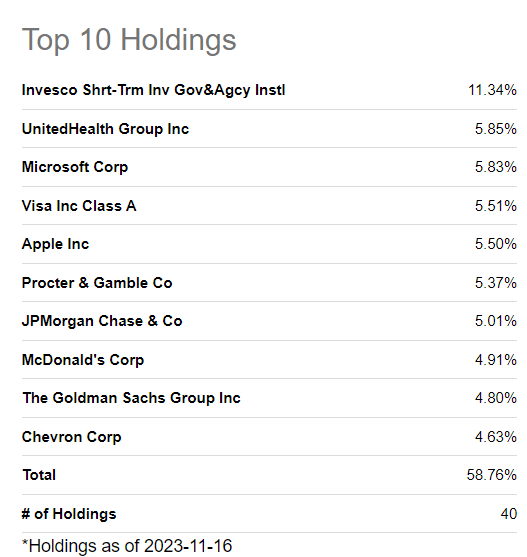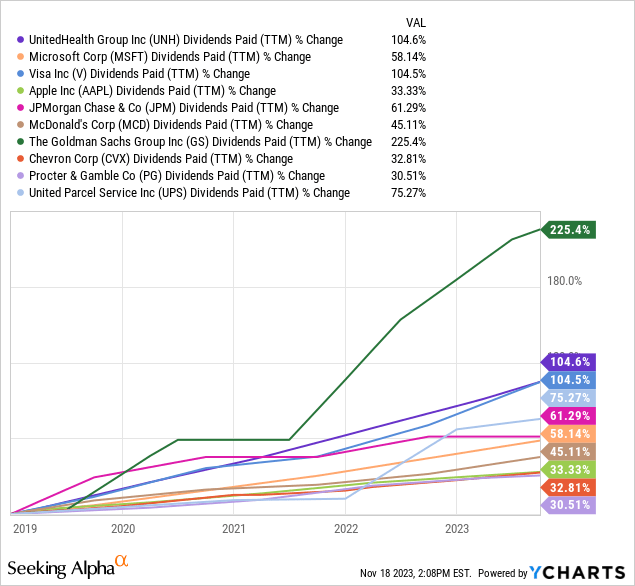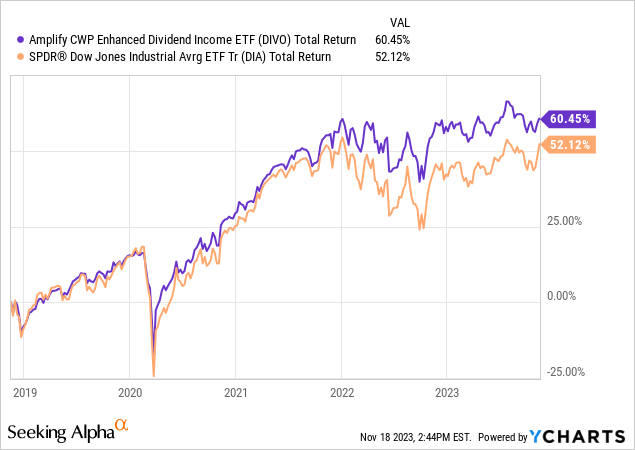Amplify CWP Enhanced Dividend Income ETF (NYSEARCA:DIVO) is an interesting income oriented fund which I covered in the past.
DIVO Underperforms In 2023 But It’s A Long Play For Conservative Investors
In this article I will look at if the fund has room for dividend growth in the future. The fund currently enjoys a dividend yield close to 5% and roughly half of this yield comes from its holdings while the rest comes from the fund’s covered call writing which is actually very limited in scope and highly selective. The fund only writes calls against 20% of its positions and allows the rest of the positions to run higher so that it can capture some upside.

The Fund’s Approach (Amplify)
Although the fund says it uses an active approach to selecting stocks and doesn’t use indexing, it just happens that a majority of its holdings are Dow Jones Index (DJI) components which I mentioned before in a past article covering this fund. It’s not a bad thing necessarily but just know that DIVO’s performance will probably match performance of the Dow Index in the long run. It also explains why the fund was underperforming S&P 500 and Nasdaq this year while outperforming them last year because that’s just how Dow did this year.

Fund’s Top Holdings (Seeking Alpha)
Having said that, the fund holds a lot of stocks with a strong history of dividend growth. When we look at the fund’s top holdings, every single one of them has grown their dividends in the last 5 years anywhere from 30% to 225%. If we remove outliers, most of them posted 5-year dividend growth rates ranging from 30% to 100% which is very strong.

Unfortunately this solid dividend growth didn’t show up in the fund’s own dividend distribution history. In the last 5 years the fund posted an annual compounded dividend growth rate of 2.61% with total 5-year growth of 14% which was less than half of the growth rate of its major holding with the slowest dividend growth (PG) which grew its dividends by 30% during the same period. In the last 1 to 3 year period the dividends didn’t even grow at all. We know that half of DIVO’s dividend distributions come from what it receives from its holdings and the other half comes from writing covered calls, so even if it achieved half of the dividend growth its holdings achieved in the last 5-years, it would have posted a dividend growth rate of 25% during this period but it didn’t. This is concerning.

DIVO Dividend Profile (Seeking Alpha)
When we look deeper into fund’s full holdings we are seeing that it wrote covered calls against Caterpillar (CAT), Home Depot (HD), JPMorgan (JPM), Microsoft (MSFT) and Goldman Sachs (GS). These calls are typically one month out and all out of money but none of these companies except for Microsoft have a high IV so the return should be small. Since the fund only needs to generate about 0.25% per month from covered calls to cover its dividend, this is not going to be too difficult either though.

DIVO’s Covered Call Positions (Amplify)
Here is the thing though. Even though DIVO hasn’t caught up with the dividend growth of Dow stocks that it holds, it still beat Dow jones index in total returns in the last 5 years. At least that’s good to know.

Then why are the dividends not growing? It looks like DIVO’s NAV has been growing in recent years. It’s actually up 21% in the last 5 years even after paying about 5% in dividend distributions every year. Basically we are looking at an annual NAV growth of 4% in addition to 5% dividend distribution. It is possible that the fund is not distributing everything it can and holding back some of its gains to preserve or even grow its NAV over time so that it doesn’t suffer from the same fate of constant NAV decay that a lot of high-yield funds find themselves in.

As an investor I am a big fan of dividend growth because it serves multiple purposes. First, it protects you from inflation which has been a major theme in recent years. Historically the US has a long-term average inflation rate around 2% but there are periods where inflation rate jumps to double digits like 1970s or last year so investors can be somewhat protected from them with dividend growth. Second, dividend growth can also help compound your total returns. If you receive a 5% yield every year for 20 years with no dividend growth and reinvest all your dividends, you will post a total gain of 165% at the end of 20 years. If you did the same but your dividends grew by just 1% per year, your total return jumps to 192%. If your dividends grow by 3% per year, your total return climbs even higher to 266%. And if your dividend growth matches the long term dividend growth rate of Dow index which is around 7%, your total return is as high as 595% at the end of 20 years so dividend growth really helps.

Total Return of 5% yield, reinvested, held for 20 years (The Author)
This is why I mostly invest in stocks and funds with a history of dividend growth or those that have such high yields that I can take a portion of those yields and reinvest in order to grow my dividends over time manually. Compounding really works over time.
We know that many of DIVO’s holdings will continue to grow their dividends over time because most of them have well-established dividend growth histories spanning many years or decades. As the fund’s NAV keeps growing, it will also give the fund more ammo to write more call options against its positions which can allow it to grow its dividends further. Still, the fund’s management has to make that decision to raise its distributions. Legally speaking, most funds, ETFs and CEFs have to return their realized gains to investors in shape of distributions in order to avoid getting taxed but many times they can avoid this by harvesting capital losses (closing a stock position for a loss to eliminate realized gains) if they have any if they want to not increase their distributions.
Does DIVO have room to increase its distributions? Probably. Is the fund overdue for a distribution hike? Most likely. Will it actually do it? That’s what we don’t know. The fund’s management will have to decide that.
Read the full article here












